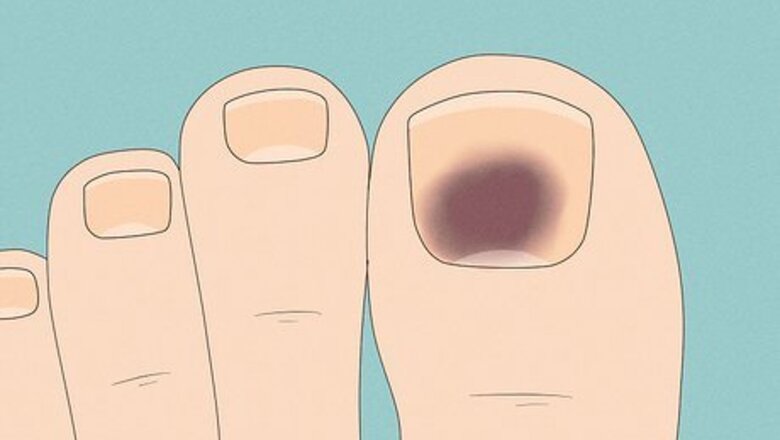
views
X
Research source
Even if your toenail is dead and has completely stopped growing, you can remove the toenail and treat the underlying infection.[2]
X
Trustworthy Source
American Academy of Dermatology
Professional organization made of over 20,000 certified dermatologists
Go to source
By removing a nail, you can help prevent infection and help the nail heal from an injury. With the proper treatment, your toe will be back to normal in six to 12 months.[3]
X
Research source
It's best to have advice of medical professional before attempting removal of your toenail.
- If there’s a blood blister under the nail, pierce the nail with a sterilized pin to drain it.
- Trim away as much of the dead nail as you can.
- Remove new pieces as they begin to loosen naturally.
- Keep your toe clean and bandaged until the nail bed heals.
Taking Care of a Blister
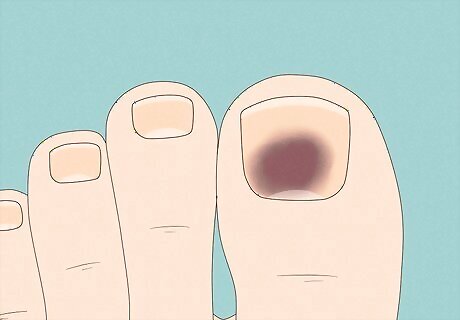
Note the presence of a blister. Dead toenails are often created when blood blisters develop beneath the nail. The blister causes the skin underneath the nail to die, and once that skin dies, the nail separates and lifts away from the toe. If your toenail has died for another reason, including a fungal infection, there will likely be no blister to drain. Skip directly to the "Removing the Toenail" section of this article and follow the same removal and aftercare procedure. In the case of a fungal infection, visit your doctor, who can prescribe a suitable antifungal cream. Do not attempt to drain a blister underneath your nail if you suffer from diabetes, have peripheral arterial disease, or have any problems with your immune system. These scenarios can result in a long-term, hard-to-treat infection and wounds not healing appropriately due to decreased immune system and lack of blood flow for healing. In this case, you must consult your physician.

Clean the toe. Wash the toe and nail area with soap and water. Wash your hands with soap and water, as well. It is critical that you make your toe and hands as sterile as possible before attempting to pierce your blister or remove your toenail. If there are bacteria present, you are placing yourself at risk of infection. You may want to consider swabbing the toenail and surrounding area with iodine. Iodine has been shown to kill the bacteria that cause infection.
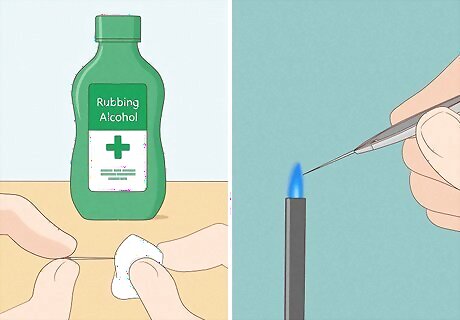
Sterilize and heat the tip of a pin or straightened paperclip. Wipe a clean, sharp pin, needle, or the end of a paperclip with rubbing alcohol in order to sterilize it. Heat the tip of the sharp object of your choice in a flame until it is visibly red-hot. To best avoid infection, this process should be done with the supervision of a medical professional. Any time you attempt a medical procedure at home—even the simplest procedure—you put yourself at risk for infection or making a painful or dangerous mistake. Consider visiting your doctor or an urgent care clinic to drain the blister under your toenail instead of doing it yourself. Note that a blunt metal paper clip can be used instead of a pin if you feel uneasy about piercing the blister with a sharp point. If you have never tried to drain a blister, using a paperclip might be a safer option. However, have a sterilized pin on hand as you may need it to pierce the blister. Only heat the tip of the pin. The rest of the pin will become warm, but only the tip should become red-hot. Be careful not to burn your fingers while handling it.
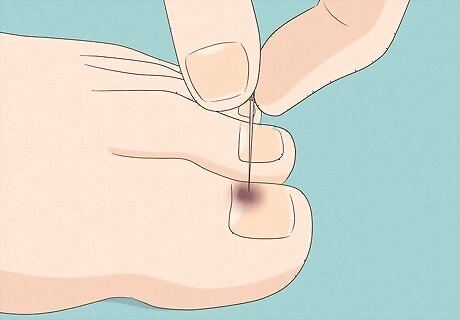
Melt through your nail with the tip of the pin. Position the heated tip of the pin over the nail, just above the blister. Hold it still and allow the heat to melt a hole through the nail. Since there are no nerves in a nail, using a hot pin to melt it should not cause any pain. Avoid applying pressure when melting your nail, as you want to be careful not to burn the skin or poke the sensitive tissue underneath. Depending on the thickness of your nail, you may need to reheat the pin several times and repeat the melting process at the same spot on your nail each time.
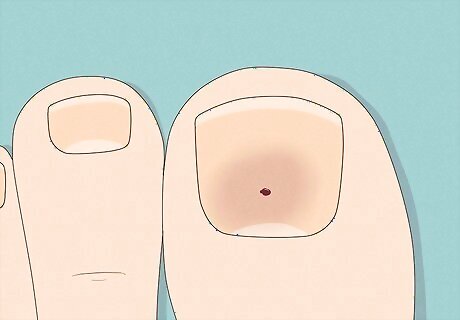
Let the blister drain. After creating a hole in the nail, allow the fluid to drain out. You should feel immediate relief from any pain and pressure caused by the buildup of blood under your nail. You may notice clear or bloody fluid seeping out of the hole over the next few days. If you still feel a lot of pain after draining the blister, call your doctor. It’s possible that you have a more serious injury to the nailbed.
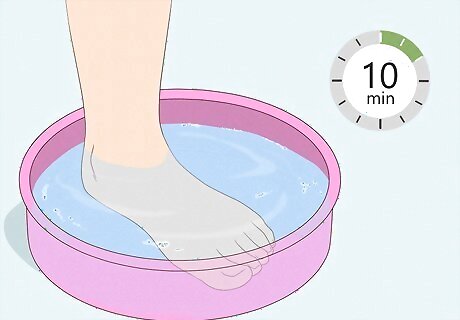
Care for the wound. Immediately after draining the blister, soak the toe in warm and slightly soapy water for approximately 10 minutes. After that, continue to soak the nail in soapy water for 10 minutes, 3 times a day, for the next 3 days. Depending on the size and severity of your blister you might need to drain it multiple times until all the fluid is completely gone. Try to drain any remaining fluid from the blister from the same hole you previously created in your nail.
Removing the Toenail
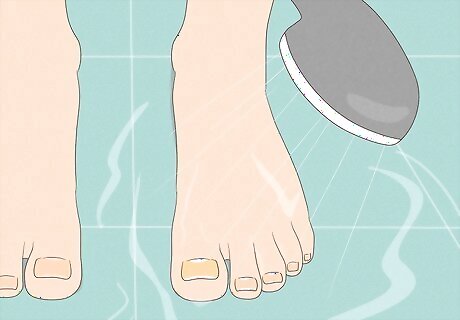
Wash the area around your toe. Before attempting to remove part or all of the toenail, clean the toe with warm, soapy water. Dry it well before continuing. Cleaning your foot, toe, and nail area as well as possible before any toenail removal will help to prevent infection. In addition to your foot, clean your hands to lessen the chance of transmitting bacteria.
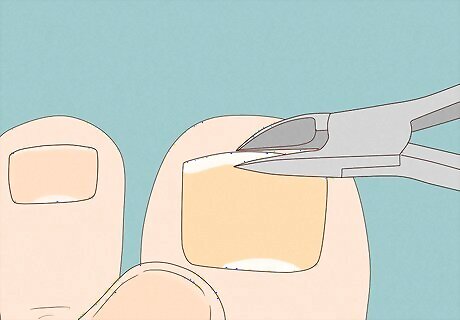
Trim as much of the upper portion as possible. Clip away the portion of your nail that is resting on dead skin. This makes it more difficult for dirt and bacteria to become lodged beneath the dead nail. Removing the nail will also help the skin beneath the nail to heal faster. To minimize the risk of infection, you may want to sterilize the clippers with rubbing alcohol before use. Sharp nail clippers are also better to use than blunt nail clippers since the latter may tear the nail as you attempt to remove it.
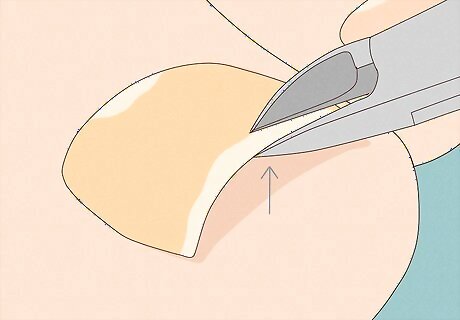
Test the nail before trimming it. If the nail has already started dying, you should be able to pull a portion away from your skin without difficulty. The portion you can pry away without feeling any pain is the part that you will want to clip off.
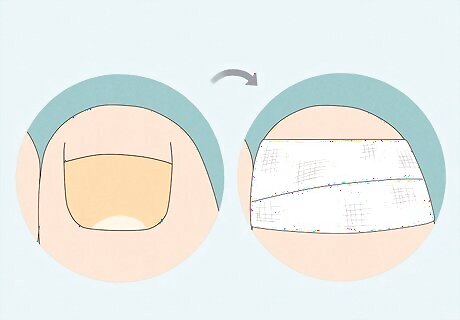
Wrap the toe. After removing the top portion of the nail, wrap the toe with an adhesive bandage. Your newly exposed skin will probably be raw and tender, so wrapping your toe will help to minimize the discomfort that you may feel. You may also want to apply antibiotic ointment or petroleum jelly to the skin to encourage healing and reduce the risk of any infection.
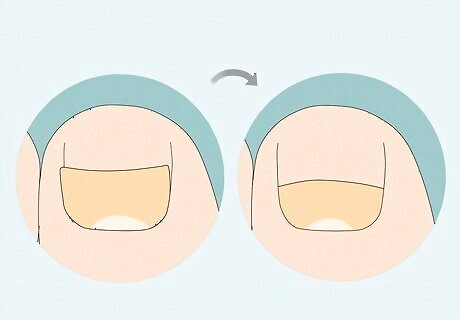
Keep trimming away the rest of the nail as it comes loose. Don’t try to pull off any pieces of nail that are still attached to the nail bed. The dead nail will eventually completely detach and fall off on its own. However, you can safely continue to trim or file off new pieces as they come loose or grow out.
Providing Aftercare
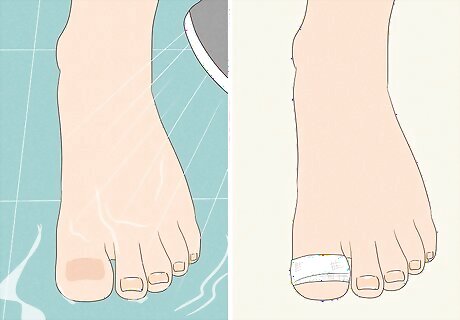
Keep the area cleaned and dressed. Once you remove the remainder of the nail and expose the raw skin, clean the toe with warm water and some gentle soap. In addition, apply an antibiotic ointment and loosely bandage the toe. Remember that this is a wound, and you must treat it gently until a new layer of skin grows.
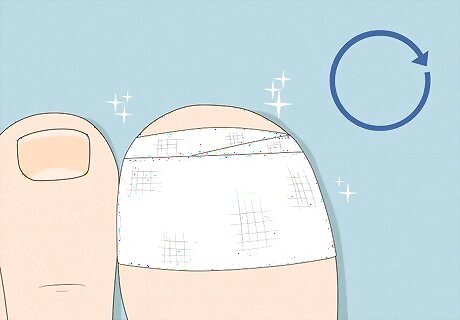
Change the bandage every 24 hours. Since the bandage may stick to the exposed nail bed if you leave it on too long, change it at least once a day. Change the dressings more often if they get wet or dirty. If the bandage does stick, soak it off with warm water. Clean the wound and apply a fresh layer of antibiotic ointment or petroleum jelly any time you change the bandage.

Treat the exposed skin. Apply an antibiotic ointment or cream to the wound at least once a day to help stave off infection. Continue until new skin grows over it. An over-the-counter cream will suffice in most situations, but you may need a prescription cream prescribed by your doctor if you get an infection. Some doctors advise soaking the injured nail in warm salt water for 20 minutes, 2 to 3 times a day, to keep the nail bed moist and reduce the risk of infection. If you do this, allow the nail to dry and cover it with a fresh layer of ointment before putting on new dressings.

Stay off your feet. Rest your foot as much as possible for the first few days after removing the nail, especially since it will probably be quite painful at this point. Once the pain and swelling go down, you can gradually ease yourself back into your normal routine, including exercise. However, you should not push yourself to do something that causes pain. If possible, keep your foot elevated when you sit or lie down. Prop it up so that it's above the level of your heart. This can help minimize any swelling and pain you may experience. While the nail is growing, avoid wearing narrow or tight shoes that may cause trauma to the nail. Wear closed-toe shoes as much as possible to further protect the nail bed as it recovers, especially when you are doing physical activity outside.
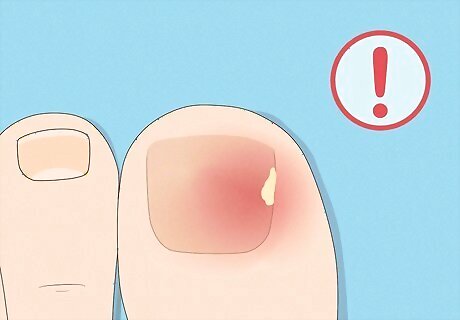
Know when to contact your doctor. Symptoms such as severe pain can be a sign of infection. Other common signs of infection include swelling, warmth around the toe, drainage of pus from the toe, red streaks extending out from the wound, or fever. Don’t wait until the infection becomes serious—contact your doctor at your first inclination that something may not be right.


















Comments
0 comment